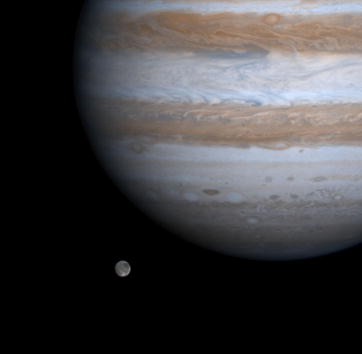Jupiter's 80th moon might really exist as a newbie astronomer claims that she spotted the additional natural satellite of the planet in its 2003 photo, which the Canada-France-Hawaii Telescope or CFHT captured.

If her claim is proven correct, space experts claim that it will be the first time an amateur astronomer discovered a new moon in the solar system.
Kai Ly, the young, lucky space expert who discovered the Red Giant's 80th moon, contacted the Minor Planet Mailing List on Wednesday, June 30.
"Lately I've been working on a rudimentary project to revisit a comprehensive Jovian moons survey by Jewitt, Sheppard and Gladman et al. in 2003, which for some reason was largely undocumented despite its fruitful result of 23 Jovian moon discoveries," she explained.
"For a full-scale survey of Jupiter's Hill sphere like this, the data is very much unexplored when you consider that many of the recently-discovered moons (i.e. Ersa and Valetudo) were present and clearly visible in this dataset but were not reported hitherto," added the newbie space researcher.
Is Jupiter's 80th Real?
According to NASA Science Solar System Exploration's report, Jupiter only has 79 moons. The international space agency added that only 53 of these natural satellites are named.

Also Read : How's the Weather on Venus Like at Night? Climate Orbiter Akatsuki Gives Scientists Answers
The National Aeronautics and Space Administration added that the remaining 26 moons still don't have official names. On the other hand, the International Astronomical Union's Minor Planet Center also recognizes the record of NASA when it comes to the total number of Jupiter's moon.
However, Ly contradicted this idea and submitted a paper for Jupiter's 80th moon recognition. PetaPixel reported that the amateur astronomer studied three survey images.
These photos specifically cover the same region of the sky at different periods. She claimed that the 80th planet of Jupiter has an orbit that is secured for the following decades.
Her finding was confirmed by David Tholen of the University of Hawaii. Thanks to his recognition, Ly claims that her discovery is just one of the upcoming amateur astronomer space discoveries.
Ly Says Her Discovery Came From Her Summer Hobby
The amateur astronomer said that she didn't specifically look for the 80th moon of the Red Giant planet. Ly explained that their moon-hunting activity was just a part of their summer hobby before going back to school.
Her accomplishment also attracted other popular newbie astronomers, such as Sam Deen.
For more news updates about Jupiter's 80th moon and other similar discoveries, always keep your tabs open here at TechTimes.
This article is owned by TechTimes
Written by: Griffin Davis
ⓒ 2025 TECHTIMES.com All rights reserved. Do not reproduce without permission.




